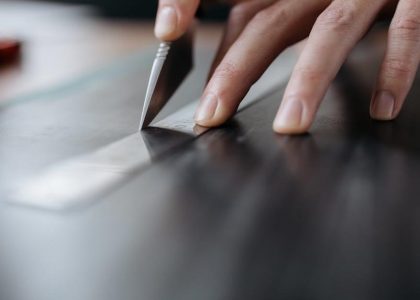Understanding the 3-Hole Punch
A 3-hole punch is a common office tool that creates standardized holes for binder insertion. Understanding its function is key for organizing documents, whether in the office, school, or at home.
Standard Hole Spacing and Dimensions
Standard 3-hole punches adhere to specific dimensions to ensure compatibility with binders. Typically, the center of each hole is spaced 4.25 inches apart. The distance from the edge of the paper to the center of the first hole is around 0.5 inches, though slight variations can occur. These standardized measurements are vital for consistent filing. Understanding them will help you to align your papers correctly and maintain neatness. Using a centering guide ensures your holes match these standard dimensions perfectly for better organization.
Types of 3-Hole Punches
Various 3-hole punches exist, each designed for different needs. These range from manual models for light use to electric and heavy-duty options for larger volumes, offering diverse solutions for every situation.
Manual 3-Hole Punches
Manual 3-hole punches are operated by hand, using a lever to punch holes through paper. They are a common choice for low-volume hole punching needs in homes, schools, or small offices. These punches come in various sizes, with some featuring a SmartTouch design that reduces the effort required to punch through stacks of paper. The convenience and simplicity of these punches make them a staple in many environments. Ergonomic designs often include soft grip handles for increased comfort during use, ensuring a stress-free manual punching experience for users.
Electric 3-Hole Punches
Electric 3-hole punches automate the hole-punching process, offering a faster and more efficient solution for larger volumes of paper. These punches can drill two or three 1/4″ holes through up to 30 sheets of 20 lb. paper simultaneously, saving time and effort. Models are adjustable, allowing users to switch between two-hole and three-hole configurations. Ideal for busy office environments, electric punches provide consistent and precise hole placement with minimal physical exertion. They enhance productivity and streamline document preparation processes. They are a useful tool for high volume needs.
Heavy-Duty 3-Hole Punches
Heavy-duty 3-hole punches are designed for high-volume punching, capable of handling thicker stacks of paper with ease. Constructed with durable materials like die-cast metal frames, these punches withstand frequent use. They often feature ergonomic levers to reduce the effort required for punching, even through up to 40 sheets of paper at once. These models are essential for offices and environments with significant document preparation needs, ensuring consistent and reliable performance over extended periods. Adjustable hole positions further increase their versatility for various paper sizes.

Using a 3-Hole Punch: A Step-by-Step Guide
Using a 3-hole punch involves aligning paper using integrated guides for consistent hole placement. This ensures documents fit properly into binders, simplifying organization and maintaining a professional appearance.
Aligning Paper with Integrated Guides
The first step to using a 3-hole punch effectively involves correctly aligning your paper. Integrated guides are crucial for this, ensuring the holes are positioned uniformly on each sheet. These guides often consist of adjustable edges or markings on the punch. By placing your paper against these guides, you can achieve consistent margins. Proper alignment prevents crooked holes, which can lead to difficulties when inserting papers into binders. Always double-check the alignment before punching to maintain a professional and organized look to your documents.
Punching the Holes
Once the paper is aligned, the next step is to punch the holes. Most 3-hole punches operate with a lever mechanism. Apply firm, even pressure to the lever to ensure clean holes. Avoid forcing the lever if the paper stack is too thick, which can cause jams or misaligned holes. Some punches are designed with reduced-effort technology for easier operation, especially for larger stacks of paper. After punching, check the holes for any tears or incomplete punches. If necessary, realign and repunch the affected sheets.

Troubleshooting Common Issues
3-hole punches can occasionally experience issues. Common problems include misaligned holes and paper jams. Addressing these issues promptly ensures smooth operation and prevents damage to documents or the punch itself.
Misaligned Holes
Misaligned holes in 3-hole punched documents can be frustrating. This issue often arises from improper paper alignment within the punch. Ensure the paper’s edge is flush against the guide. If misalignment persists, examine the punch mechanism for any obstructions or damage. Also, consider the centering guide’s adjustments, as incorrect settings can lead to off-center punching. Proper alignment is crucial for creating organized documents. Review your technique and equipment for consistent results.
Paper Jams
Paper jams in a 3-hole punch can disrupt workflow and damage documents. Overloading the punch beyond its sheet capacity is a common cause; Always adhere to the recommended sheet limit to prevent jams. Ensure the paper is properly aligned before punching to avoid uneven pressure. Remove any torn or crumpled paper from the mechanism. A paper jam can happen if the paper is not pushed to the end of the paper tray.
Choosing the Right 3-Hole Punch
Selecting the right 3-hole punch depends on your needs. Consider paper volume, durability, and material. Features like centering guides and comfortable handles are also crucial for efficient use.
Considerations for Paper Volume
When choosing a 3-hole punch, paper volume capacity is paramount. For occasional use with a few sheets, a standard manual punch suffices. However, for frequent, large-volume tasks, a heavy-duty or electric punch is more suitable. Manual punches typically handle 10-40 sheets, while heavy-duty models can manage hundreds. Electric punches offer speed and ease for high-volume needs. Consider the frequency and quantity of your punching tasks to select a punch that meets your demands without causing strain or inefficiency, ensuring smooth and consistent performance.
Durability and Construction Material
The durability of a 3-hole punch depends heavily on its construction material. Metal punches, especially those with die-cast frames, offer superior longevity and can withstand frequent use. Plastic components, while lighter, are more prone to wear and breakage. A sturdy construction ensures consistent performance and prevents misalignment over time. Look for models with hardened steel punch heads for clean, reliable holes. Consider the frequency of use and the thickness of paper to ensure the chosen punch can endure the workload. Investing in a robustly built punch saves money in the long run.
Centering Guides and Their Importance
Centering guides are essential for accurately aligning paper in a 3-hole punch. They ensure consistent hole placement, creating neat and professional documents. These guides minimize errors and improve organization.
Ensuring Consistent Margins
Consistent margins are crucial for maintaining a professional and organized appearance in documents. A 3-hole punch centering guide helps ensure that the holes are punched at the same distance from the edge of each sheet. This is vital for creating a uniform look when papers are placed in a binder. A guide helps to avoid the sloppy look of misaligned sheets. Consistent margins contribute to the overall readability and visual appeal of the document, making it easier to process the information presented and creating a positive impression.

Applications of 3-Hole Punches
3-hole punches are widely used for organizing documents in binders. They are essential for offices, schools, and home organization. The tool provides a simple way to keep papers secure and accessible.
Office Document Organization
In an office setting, the 3-hole punch is indispensable for maintaining organized files and records. It enables efficient categorization and storage of important documents in binders. By using a 3-hole punch with a centering guide, ensures consistent margins, which presents a professional appearance. Standardized hole spacing allows for easy insertion and removal of papers, contributing to a streamlined workflow and improved document management within the office environment. This promotes efficiency and accessibility.
Educational Materials
In educational settings, the 3-hole punch plays a vital role in organizing student assignments, notes, and handouts. Teachers and students alike benefit from using a 3-hole punch to compile materials into binders for easy access and review. A centering guide ensures a uniform and organized appearance, which promotes better focus and study habits. Using a 3-hole punch can help students keep track of their coursework, making it an essential tool for effective learning and academic success during classes and lectures.

Maintenance and Care
Proper maintenance ensures your 3-hole punch operates efficiently for years. Regular care, like emptying the chip tray, prevents jams and extends the tool’s lifespan. A well-maintained punch delivers consistent results.
Emptying the Chip Tray
The chip tray, designed to collect the paper remnants from punching, requires regular emptying. When the tray becomes full, it can cause jams and misaligned holes. Neglecting this task results in a messy workspace and inconsistent punching. Most trays are easily removable, allowing for quick disposal of the paper chips. Establish a routine for emptying the tray to maintain optimal performance and prevent frustrating interruptions during document preparation. A clean workspace contributes to efficient workflow and accurate hole alignment.
Alternatives to 3-Hole Punches
While the 3-hole punch is standard, alternatives exist for different needs. Options include single hole punches for individual sheets and adjustable punches for varied hole configurations. Consider the specific application when selecting an alternative.
Single Hole Punches
Single hole punches offer a compact alternative for situations where only one hole is needed. These are ideal for tagging, crafting, or creating simple document attachments. They’re smaller, more portable, and often more affordable than multi-hole punches. The size-adjustable punch can be placed anywhere you need on your paper project. Perfect for layouts requiring eyelets or carefully placed holes for detailing.
Adjustable Hole Punches
Adjustable hole punches offer greater flexibility than standard models, allowing users to customize hole placement and spacing. These punches often accommodate various paper sizes and binding systems. They are especially useful for non-standard documents or creative projects. The SKILCRAFT Manual Adjustable 3-Hole Punches will drill 1/4 holes through up to 30 sheets of 16 lb. paper or 25 sheets of 20 lb.





